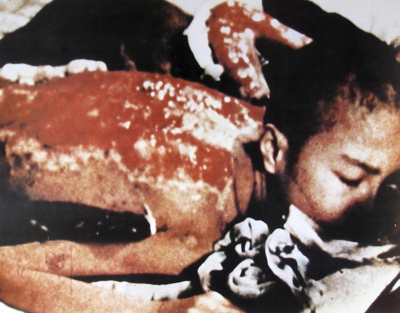

Thermal Radiation Heat Burns
This boy was exposed to thermal radiation approximately one mile from the Nagasaki hypocenter. Photograph by U.S. Army, November 1945.
The thermal radiation consisting of ultraviolet rays, infra-red and light rays follows a nuclear explosion which creates a tremendous amount of heat, comparable to the interior of the sun in a volume of space a few inches in diameter. Because the reaction is completed in microseconds a violent explosion results. Near the hypocenter the temperature of 6,000 degrees centigrade incinerates the body, blisters tile surfaces and instantly ignites flammable objects. At distances of about three kilometers the skin is charred, but at distances closer to the hypocenter, internal tissues are injured as if they are roasted and death occurs immediately. As thermal radiation and the penetrating nuclear radiation of gamma rays and neutrons act upon the body simultaneously, the combined effects were lethal for those out in the open within 1,500 meters of the hypocenter, even for those who were not injured by the trauma.
The blast waves caused injury not only because of their tremendous force that buckled concrete walls like the force of an earthquake at close distances from the hypocenter, but in addition they created a blast wind of hurricane speed that flung bodies off the ground several meters, that turned loose objects into flying missiles and the shattered glass fragments of varying size into flying blades cutting or penetrating the body. Furthermore, the skin that just seconds before was scorched by the thermal radiation was ripped off leaving strips of skin hanging from the body and exposing bleeding skin surfaces. The blast wind left clothing in tatters while others were completely naked.
At the Medical School hospital it was often noted that individuals without burns or trauma injury died, some instantly, slumping at their workplace, while others died in the next day or two after the bombing and solely from what was later determined to be radiation effect on the brain, "brain death."
In common they soon experienced extreme malaise, extreme thirst, vomiting and diarrhea. With a longer survival period epilation developed followed by bleeding from the skin and other parts of the body and painful ulceration in the throat and gums, often accompanied by sustained high temperature and emaciation prior to death. Those who developed infections required a long period before healing ensued. Otherwise localized infections often spread into a generalized fatal sepsis. Victims in whom radiation sickness was delayed for several weeks after the exposure were more likely to survive.